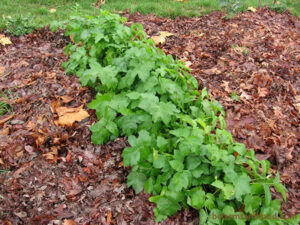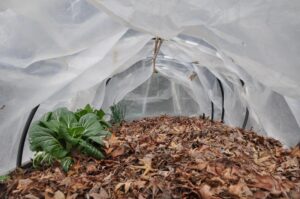This Toronto Master Gardeners’ guide discusses whether gardeners should put their fall leaves onto garden beds to protect their beds during winter. Like many gardening questions, the answer is a bit subtle. What to do with your leaves depends on:
- what species of tree you have
- whether your tree is showing signs of damage from disease
- whether the leaves are on your lawn or in your garden beds
- whether you will be shredding the leaves before you place them on garden beds and the lawn

Source: https://bcfarmsandfood.com/extend-the-growing-season/
Leave your Leaves in your Garden
Back in 2015, the National Wildlife Federation started a movement called “Leave the Leaves” and initiated a “Leave the Leaves Month”. Their reasons were to encourage people to use their fallen leaves to enhance and fertilize their soil, suppress weeds, and provide habitat for animals and pollinator insects. This initiative is now supported by authoritative organizations such as the United States Department of Agriculture, the Nature Conservancy of Canada, the David Suzuki Foundation, the Xerces Society for Invertebrate Conservation, and the City of Toronto. The strong recommendation from all these organizations is to leave your fallen leaves in your garden.
The benefits to the soil and our gardens’ microclimate from leaving leaves on our garden beds are numerous and compelling.
- The dropped leaves create a natural mulch around tree roots that helps moderate the temperature and conserve moisture for the trees.
- The leaves hold many macro- and micro-nutrient chemicals, and if they are constantly removed, the soil will become depleted of these nutrients. However, if the leaves are kept, the nutrients are preserved.
- Leaves, once they have broken down, improve the soil texture by increasing aeration and porosity in clay soil and improving water retention in sandy soil. The leaves become the organic matter that helps the soil aggregate into “peds” (lumps) that allow for stability and pore space. Leaf litter also acts as a mulch protecting the soil from erosion and compaction while helping to retain moisture.
- The leaves provide shelter and food to a variety of wildlife such as lizards and some frogs that overwinter beneath the fallen leaves, and provides nesting materials for birds that forage about in them to look for food. The USDA notes that these living creatures are also important in helping to control pests.
- Some moths and butterflies overwinter (in all four stages of their metamorphosis) in the leaf litter. These are the pollinators that our garden will need for the next growing season.
- The most compelling reason “to leave the leaves” is to improve the soil microbiome (which includes a wide variety of microscopic insects, mites, bacteria and fungi). These organisms in the soil microbiome are essential in making soil and in breaking down organic matter into the elemental forms that plants can use. These micro-organisms need a supply of organic matter, and leaves are an important source of that organic matter. (For more information on leaves and the soil biome, see Cathy Kavassalis Leave the leaves.)
How and where to “Leave the Leaves”
Having outlined all the amazing benefits that leaves offer our garden, there are a few variables worth discussing.
- Should you shred the leaves and then put them on the garden bed or leave them whole?
- How thick should the layer of leaves be?
- Should you leave leaves on your lawn?
Shredding the leaves with a mulching mower before you put them on your garden beds has the advantage that the leaves will break down quicker and hence be accessible to the soil biome quicker. This may not be necessary depending upon the leaves you have. Smaller leaves will break down over the winter, and maple leaves will just take one season (both winter and a few summer months) to break down. However, if you do not shred oak leaves, the whole oak leaf can take about five years to break down. Perennial plants will not be able to grow through a thick mat of oak leaves.
There is a disadvantage to shredding leaves. There is a risk that the shredding process will kill hibernating insects and their larvae. These become our pollinators in the spring and food for newly hatched birds, which survive solely on insects during their first weeks of life. One solution may be to leave some leaves whole, while shredding others. This addresses the problem since you will be leaving whole leaves for pollinator homes, while also quickly improving the soil microbiome with the shredded leaves. Another suggestion for those with no mulching mower, is to leave the leaves on the garden beds over winter but remove them in the early spring and put them in your compost, with layers of other plant material to help them decompose.
Note: it is better not to rush the spring clean-up until temperatures are consistently above 10C. Many butterflies and solitary bees overwinter in dead leaves and only leave the leaf litter at a certain temperature over a period of days. See Spring Clean-up: A Toronto Master Gardeners Garden Guide.
An additional question is how deep a layer of leaves to have on your garden bed. The suggestion from Xerces is to have about two inches of leaves since this is the depth of bedding leaves that mimics the natural ecosystem, but most perennials can happily grow through three inches of shredded leaves or smaller whole leaves.
Thirdly, when it comes to your lawn, rake the leaves off your lawn and put them onto your garden bed. If you can, shred the leaves with the mulching mower, then rake a thin layer of these shredded leaves into your lawn, thin enough so that you can see grass through the leaf layer.

Source: https://extension.oregonstate.edu/news/mulch-key-no-till-gardens
Disadvantages to Leaving the Leaves
There are a few concerns that need to be acknowledged about “leaving the leaves” in our gardens. However, neither of them (creating a habitat for invasives or spreading disease) may be reason enough for not using your leaves and gaining all the advantages of “Leaving your Leaves” in your garden.
Creating a habitat for invasives
- You may be creating a habitat for invasive pests such as ticks and jumping worms – and leaves may also be a way for the jumping worm eggs to spread
The habitat of ticks that carry Lyme disease has extended north as the weather has warmed. Ticks are mostly found in wooded and grassy areas and can overwinter in leaf litter. If your garden is in an area that is infested with ticks, the suggestion from Health Canada is to make sure you keep your grass well cut and create a cleared path between your cultivated garden and more naturalized trails where wildlife walk.
There is a possibility that fallen leaves may have the Asian jumping worm eggs in them and because of this, the Master Gardeners of Ontario Inc. (MGOI) is encouraging people not to pick up bags of leaves from gardens other their own. This is a sensible “hygiene practice”, (encouraged by the Halton Master Gardeners in their November, 2023 monthly newsletter of Cross Pollination, pg. 14), while we are still finding out more about the spread of these destructive invasives.
Spreading fungal diseases
Another issue with preserving the leaves from your garden is that:
- Keeping leaves that have been infected with fungal diseases may increase the rate of disease the following year
In Toronto, the two major fungal diseases are powdery mildew that affects the city’s Norway maples, leaving a white mold on top of the leaves, and tar spot that creates oval or irregular-shaped yellowish-green spots on the upper surface of leaves that blacken over time.
The City of Toronto recommends that you clean up the infected leaves from the trees, and place them out for municipal collection, to prevent future infection. The City of Toronto’s municipal composter reaches temperatures during the composting process that will kill most pathogens.
Using diseased leaves as mulch over winter
On the other hand, there are compelling reasons for using the leaves that fall from our trees even if they are infected with tar spot or powdery mildew.
- These fungal diseases are not killing the trees. This really is an aesthetic issue. The fungi are turning the leaves an unattractive colour, and their fall colour seems to be not as bright as it used to be. As the City of Toronto says: “Trees are resilient and can recover from most insect feeding and leaf-distorting diseases”.
- The fungi are now so widespread throughout Toronto that there is no advantage to not using the leaves. Robert Pavlis (author of Garden Myths) says, “By fall, virtually every leaf in the garden is infected with some type of fungi, even if you can’t see anything on the leaf. If you don’t use infected leaves, you would not use any plant material. Not only are the leaves infected, but fungal spores cover every inch of soil, mulch and leaf debris. They are everywhere.” This view has also been supported by Paul Zammit, professor in Niagara College’s Environment division on one of his CBC weekly call-in radio shows, and by Larry Hodgson, the Laidback Gardener in a couple of his blog posts. The links in this paragraph will give you even more information on how widespread tree fungi are.
Conclusion
In this guide, we have presented the arguments for why you should “Leave your Leaves” but have also shown that there are some opposing views to doing so. Happy gardening.

